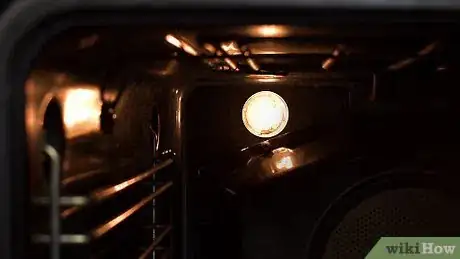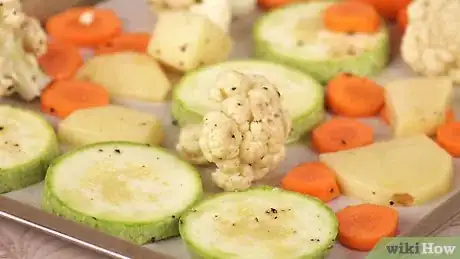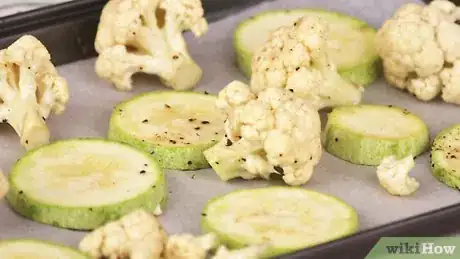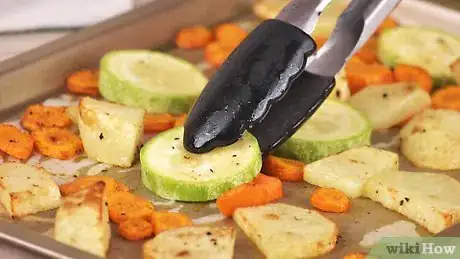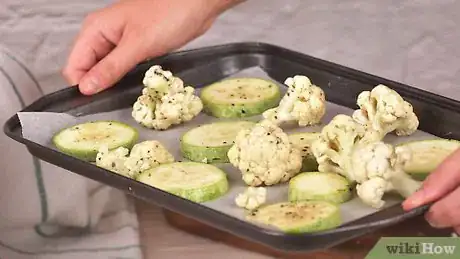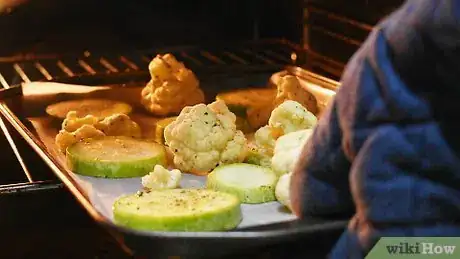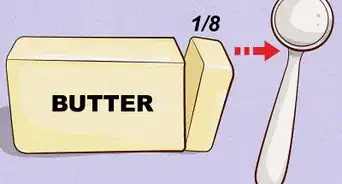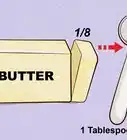This article was co-authored by wikiHow Staff. Our trained team of editors and researchers validate articles for accuracy and comprehensiveness. wikiHow's Content Management Team carefully monitors the work from our editorial staff to ensure that each article is backed by trusted research and meets our high quality standards.
The wikiHow Video Team also followed the article's instructions and verified that they work.
This article has been viewed 184,635 times.
Learn more...
There are several easy steps you can take to make your veggies perfectly roasted. Cut your vegetables into equal sizes and coat them in a thin layer of oil and seasoning to bring out their best taste. When you go to roast them in the oven, it's important to note that harder vegetables such as potatoes and carrots will take longer to cook than softer veggies like broccoli and cauliflower. When your vegetables have browned edges and soft centers, they're ready to be eaten!
Steps
Chopping and Seasoning the Veggies
-
1Preheat your oven to 400–450 °F (204–232 °C). 425 °F (218 °C) is an ideal temperature for roasting, but a temperature near this works well too. Vegetables need to be cooked at a high temperature to achieve the perfect tenderness and caramelization—if the temperature is too low, the vegetables will overcook before they reach the desired browning. For roasting frozen vegetables, the oven should be heated to 450 °F (232 °C). [1]
-
2Wash the vegetables before peeling them, if necessary. Rinse your veggies under cool running water to remove any dirt. If you're chopping up garlic or onions, make sure you peel them first with your hands. Other veggies can be peeled using a peeler or knife, such as cucumbers, eggplant, or potatoes.Advertisement
-
3Chop or dice the vegetables into small sizes. While your veggies should all be around the same size once they’re cut up, it’s best to cut harder vegetables into smaller pieces than softer vegetables. This will ensure the vegetables cook more evenly, especially when they’re all together in the same tray.[2]
- Use a sharp cutting knife to cut the veggies into cubes or small pieces.
- Softer vegetables, like broccoli and cauliflower, can be in larger pieces than harder vegetables, such as potatoes.
-
4Add oil and seasoning to the veggies. You can place the veggies in a large bowl or a plastic, sealable bag. Pour enough oil over the vegetables so that they all have a thin sheen to them; 1–3 tablespoons (15–44 ml) of oil should do the trick. Sprinkle any seasoning that you like over the veggies as well, such as salt, pepper, or fresh herbs and spices.[3]
- Olive oil is the most common to use on vegetables, but you can also use toasted sesame oil, peanut oil or safflower oil.
-
5Toss the vegetables in the oil and seasoning so they’re evenly coated. If you placed the veggies in a large bowl, you can use your hands to move the vegetables around, distributing the oil and seasoning evenly. If you put the veggies in a plastic bag with the oil and seasoning, seal the bag and gently shake it to coat the vegetables.[4]
- While you want the vegetables to be well-coated in oil, they shouldn’t be dripping.
-
6Prepare a metal baking sheet so the vegetables won't stick. Cover a large roasting pan with parchment paper or aluminium foil for an easy cleanup, or you can use a nonstick spray to coat the baking sheet. Metal baking sheets will help the vegetables roast evenly, and a metal sheet with low sides is important so that any water can easily evaporate.[5]
- The vegetables will need to have plenty of space so they roast evenly, so you may need to prepare more than one baking sheet if you’re cooking lots of veggies.
Planning Your Veggie Trays
-
1Give your vegetables plenty of space on the baking sheet. No matter how you group your vegetables, they all need enough space to roast properly. Instead of piling them on top of one another, space them out about 0.5 centimetres (0.20 in) from one another.[6]
- If the vegetables are crowded too close together, they will steam rather than roast.
-
2Spread all of the veggies on one tray to cook them all at once. If you’re short on time and want to get all of your vegetables roasted quickly, spread them all out on the tray evenly once they’re coated in oil. This works especially well if you’re cooking veggies that have similar roasting times.[7]
- You may need to keep a closer eye on this batch of vegetables to make sure they’re all cooking okay.
- It helps to chop harder veggies into smaller pieces than the softer veggies when you combine all of them together.
-
3Pair vegetables with similar cooking times together for better control. If you’re cooking a large group of both hard and soft vegetables, group all of the soft vegetables on one tray and all of the hard ones on another. This will let you easily remove the softer vegetables once they’re roasted and let the harder vegetables continue to cook.[8]
- For example, put your asparagus and green beans on one tray and your brussels sprouts and carrots on another.
-
4Add vegetables to the baking sheet in stages to monitor their roasting. If you want to cook all of your veggies on one baking sheet but also want them to be perfectly roasted, consider only putting the harder vegetables on the tray first. Once the harder veggies have cooked for a while, you can then add the softer ones to the tray.[9]
- Let your harder vegetables roast for about 10-15 minutes before adding in the softer veggies.
-
5Roast all of your vegetables individually for perfect roasting times. This takes a bit more effort, but it also gives you complete control over how long you leave each vegetable in the oven. Roast all of your potatoes on one tray, all of your bell peppers on another, and all of your string beans on another.[10]
- This method works well if you’re roasting large amounts of individual types of vegetables.
- Use more than one baking sheet at once, if possible, for faster and easier roasting.
Roasting Them in the Oven
-
1Put the veggies in the oven once it has preheated. It’s best to wait until your oven reaches at least 400 °F (204 °C) before putting the vegetables in to roast. If you put them in while the temperature is still low, they’ll get soggy instead of crispy.[11]
-
2Mix the vegetables with a spatula after 10-15 minutes. Using a spatula or similar tool to move the vegetables around the pan will help promote even browning. Doing this after they’ve been roasting for 10-15 minutes is good, though if you’re roasting only soft vegetables you might want to do it a few minutes sooner.[12]
- This is also the time to check on your veggies to make sure they’re cooking properly.
-
3Look for browned edges that indicate the veggies are roasted. Depending on the type of vegetable you’re roasting, this could take anywhere from 15-45 minutes after you put the veggies in the oven. Softer vegetables tend to only take 15-20 minutes to roast, while harder ones take 30-45 minutes.[13]
- Soft veggies such as zucchini and eggplant will only take 15-20 minutes while harder veggies such as parsnips and sweet potatoes will take roughly 30 minutes.
-
4Pierce a vegetable with your fork to see if it’s done. You want your roasted vegetables to be tender on the inside and crispy on the outside. Take the pan out of the oven and stick a fork into one of the vegetables. If it goes through easily and feels soft while the outside of the vegetable is a bit browned, it’s ready to eat![14]
- If you can’t tell whether the veggies are done or not, roast them for another 5-10 minutes just to be safe.
Community Q&A
-
QuestionWhat is the most appropriate finishing method for roasted vegetables?
 Community AnswerYou can use salt and pepper as they are always good. If you like an little tang, lemon juice helps with broccoli, green beans, asparagus, and unsalted butter finishes off Brussels sprout nicely.
Community AnswerYou can use salt and pepper as they are always good. If you like an little tang, lemon juice helps with broccoli, green beans, asparagus, and unsalted butter finishes off Brussels sprout nicely. -
QuestionI don't have an oven. Can I roast them on my non-stick pan, in a healthier way?
 Maggie PetersonCommunity AnswerYou can cook them in a non-stick pan, but they will not be roasted. Roasting involves an oven. You can cook up the vegetables with a little olive oil, salt, and pepper in the pan.
Maggie PetersonCommunity AnswerYou can cook them in a non-stick pan, but they will not be roasted. Roasting involves an oven. You can cook up the vegetables with a little olive oil, salt, and pepper in the pan.
Things You'll Need
- Cutting knife
- Oil (such as olive oil)
- Salt, pepper, desired seasonings
- Large bowl or plastic bag
- Metal baking sheet
- Parchment paper, foil, or nonstick cooking spray
- Spatula
- Fork
- Peeler (optional)
References
- ↑ https://www.chefsteps.com/activities/tips-tricks-perfect-roasted-vegetables
- ↑ https://www.bonappetit.com/story/how-to-roast-vegetables
- ↑ https://www.thekitchn.com/how-to-roast-any-vegetable-101221
- ↑ https://www.thekitchn.com/how-to-roast-any-vegetable-101221
- ↑ https://hurrythefoodup.com/how-to-roast-vegetables/
- ↑ https://hurrythefoodup.com/how-to-roast-vegetables/
- ↑ https://www.thekitchn.com/how-to-roast-any-vegetable-101221
- ↑ https://www.thekitchn.com/how-to-roast-any-vegetable-101221
- ↑ https://www.thekitchn.com/how-to-roast-any-vegetable-101221
About This Article
To roast vegetables, start by cutting them into evenly-sized pieces. Then, toss the vegetables with oil and spread them out on a pan lined with aluminum foil. Once the vegetables are spread out in an even layer, roast them in the oven at 400 °F for 15-60 minutes, depending on the kind of vegetables you're roasting. Tough vegetables like carrots and parsnips generally take longer to roast than softer vegetables like zucchini and eggplant. After they're done roasting, take the vegetables out of the oven and serve! For more tips, including how to season your veggies for the best flavor, read on!
